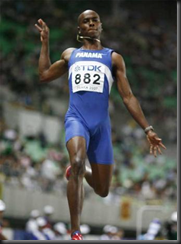Yesterday was travel day, as I was returning from a nice week long vacation. Of course I was traveling during the Stockholm meet so had to wait until last night to finally see the results. And of all the results the one I was most interested in was the men’s 400 as it was LaShawn Merritt’s first 400 in nearly two years – and there is only one month until the World Championships.
With the way the event has gone this year, I was hoping for something in the 45.25 range. I figured since the world leader was 44.65, that that would get him within the leaders, and give him time to get sharp. So I was ecstatic when I saw that he had run 44.74 and nearly pulled off the win – out of lane two!
I spent the morning reviewing videos from the meet, and Merritt’s race was very nice for an opening run. After a very solid first 300 meters, Merritt and Jermaine Gonzalez (JAM) came off the turn fairly even and ran each other to the line, the Jamaican just edging ahead for the win in 44.69. But with twenty one months of rust to knock off, I’d say a fairly impressive run for Merritt – for my money one that moves him to the head of the class for Daegu. After all, everyone else has had all year to get to where Merritt is and he did it in his debut. He looked good and almost sharp. And with a couple more runs should be extremely hard to beat. Also take note that hurdler Angelo Taylor (USA) was fourth in 44.82 and is quietly moving himself into a strong position for the 400H title!
With only a handful of competitions left, it’s really getting down to the wire and some athletes seem to be in a very solid position. One of those is Carmelita Jeter (USA), who in spite of the strong headwinds that hampered many of the days events, once again powered away to victory in the 100 meters (11.15, –2.4). Jeter is very much in a rhythm right now and looks like she is ready to improve upon the two bronze medals she’s picked up previously in World Championships competitions. In Stockholm she put away Marshevet Myers (USA) and Kerron Stewart (JAM) – two of her primary competitors for Daegu. Myers also looked very strong in second, and the U.S. should have a very solid 1,2 punch in this event at Worlds.
Another athlete that continues to set himself apart from the field is 1500 meter runner Silas Kiplagat (KEN), who fresh off his world leader in Monaco, followed the leaders through a rather slow pace before taking over in the final lap – seemingly running just hard enough to keep everyone off his heels. The results was another win, this time in 3:33.94 – showing his ability to win regardless of the pace. The best American Showing was Lopez Lamong in 7th at 3:35.87. And once again the American contingent (Russell Brown & Leo Manzano) was well off the pace and never really a factor in the race. Not giving me much hope about our chances in Korea.
We did get an unexpected boost in the men’s 110 hurdles however with a stunning run by Jason Richardson. The race was supposed to be another showdown between David Oliver and Dayron Robles, but Robles pulled out of the race. That should have meant another easy victory for Oliver as his only competition over the past couple of seasons has been Robles and Liu Xiang of China. But Richardson got a superb start and ran a very clean race. Meanwhile a couple of lanes over, Oliver was fiercely hitting hurdles. The result was a clear win for Richardson in a near PR 13.17 – INTO a –2.3 wind! And suddenly the three man race that’s been anticipated for the past year could have an uninvited fourth. Because if Richardson can run like this in Daegu he could upset more than just Oliver.
Another “surprise” could be in store in the men’s long jump. With many jumpers showing a lot of inconsistency this year, Mitchell Watt (AUS) has been an exception. His season has been strong and consistent and yesterday he caught a legal wind and jumped out to a PR 8.54m (28’ 0.25”) win to set a NR and become the first jumper over 28 feet this year! Irving Saladino (PAN) currently #3 in the world distance wise was a well back third at 8.19m (26’ 10.5”). For my money, Watt is moving into a very strong position in this event.
I was also pleased to see Jesse Williams (USA) compete strongly in the high jump taking second at 2.32M (7’ 7.25”) behind Ivan Ukhov (UKR, 2.34m 7’ 8”), but finishing well up on the Russian contingent of Silnov, Shustov and Dmitrik. It bodes well for his chances in Korea.
Finally, I must mention Sally Kipyego’s Kenyan Record win in the 5000 meters. Kipyego has been running well all season and yesterday turned in a sizzling 14:20.87 to lead a Kenyan 1,2,3 just ahead of Shalane Flanagan in 4th. Kipyego’s moved her into the #3 position all time with the #4 performance. Only Ethiopians Tirunesh Dibaba and Meseret Defar have run faster. Flanagan’s 13:46.80 was just off her PR 14:44.80 and indicates great fitness for her just ahead of the World Championships.
Stockholm was a solid meet, even if many marks were hampered by the winds. The last Diamond League competition before Worlds will be the London meeting coming up this coming Friday and Saturday – the only Diamond League meet to contest all of the sports’ events. The final “big” meet before the Big Dance. Should be a doozy!















